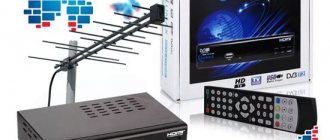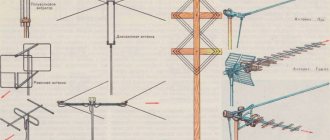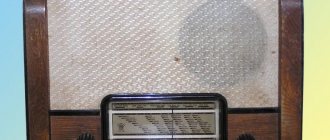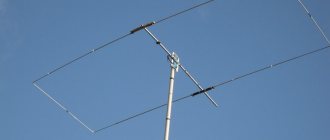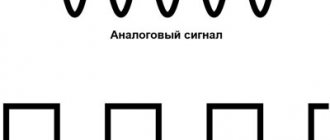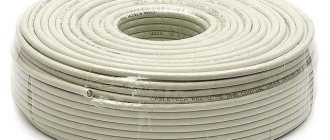Universal
There are models whose design involves both outdoor and indoor placement. It is these models that complete the rating.
| Place and name of product | Rating | average price |
| 1 Ritmix RTA-440 AV | 5.0/5 | 1 690 ₽ |
| 2 HARPER ADVB-2128 | 4.3/5 | 1 143 ₽ |
| 3 Vector AR-029 | 4.3/5 | 910 ₽ |
1 place Ritmix RTA-440 AV
5.0
3 reviews
Characteristics
- indoor/outdoor TV antenna
- with amplifier
- VHF/UHF/FM reception
- DVB-T/DVB-T2 reception
- VHF signal gain 32 dB
- UHF signal gain 32 dB
- power supply: 220 V network
- cable 1.4 m
Product reviews
Alexander G.
December 29, 2020
Excellent product
Experience of use
Less than a month
Advantages
Price, quality, design and a very convenient signal amplifier.
Flaws
I hope the weak mount for such an antenna will not be blown away by the wind.
A comment
The signal is received perfectly, 20 channels in digital, easily reaching a distance of about 15 km from the tower.
0 0
Show 3 more reviews
2nd place HARPER ADVB-2128
4.3
21 reviews
Characteristics
- indoor/outdoor TV antenna
- with amplifier
- VHF/UHF/FM reception
- DVB-T/DVB-T2 reception
- VHF signal gain 30 dB
- UHF signal gain 30 dB
- power supply: 220 V network, from antenna cable
Product reviews
Name hidden
December 20, 2019
Excellent product
Experience of use
Less than a month
Advantages
Price, ease of connection. Nice welcome.
Flaws
Haven't discovered it yet.
A comment
Country house 40 km from St. Petersburg. TV was only on the 2nd floor. And the thunderstorm antenna was connected. Since I did not want to conduct interfloor television cable wiring, I decided to purchase this antenna. It is small, in the same store I bought a three-meter f-TV cable. Connected to the console. Picks up all 20 digital channels perfectly. I didn’t take him outside. I just threw it on the closet. I recommend it to everyone.
7 3
Show 3 more reviews
3rd place Vector AR-029
4.3
3 reviews
Characteristics
- indoor/outdoor TV antenna
- with amplifier
- VHF/UHF reception
- DVB-T/DVB-T2 reception
- VHF signal gain 30 dB
- UHF signal gain 30 dB
Product reviews
Andriano U.
November 16, 2019
Excellent product
Experience of use
Less than a month
Advantages
Confident reception. It rarely freezes on only one channel. The rest are a fairy tale!
Flaws
The cable from the power supply is short, I had to adapt an extension cord.
A comment
Without haste, assemble and enjoy. If some channel does not work, turn it a little and that’s it.
0 0
Show 3 more reviews
Principle of operation
A decimeter antenna of the “wave channel” type is a set of elements: passive (reflector) and active (vibrator), as well as several directors, which are installed on a common boom. The principle of its operation is as follows. The vibrator has a certain length, it is located in the electromagnetic field of the radio signal and resonates at the frequency of the received signal. Electromotive force (EMF) is induced in it. Each passive element is affected by an electromagnetic field, which also leads to the generation of EMF. As a result, they re-emit secondary electromagnetic fields. In turn, these fields induce additional EMF on the vibrator. Therefore, the dimensions of the passive elements, as well as their distances to the active vibrator, are chosen such that the EMF induced by them due to secondary fields is in phase with the main EMF, which is induced in it by the primary electromagnetic field. In this case, all EMFs are summed up, which increases the efficiency of the design compared to a single vibrator. Thus, even a regular UHF indoor antenna can provide stable signal reception.
The reflector (passive element) is installed behind the vibrator 0.15-0.2 λ0. Its length should exceed the length of the active element by 5-15 percent. Such an antenna produces a one-way directional pattern in the vertical and horizontal planes. As a result, the reception of reflected signals and fields that come from the back of the antenna is significantly reduced. If it is necessary to receive a television signal over long distances, as well as in difficult conditions, in the presence of a lot of interference, it is recommended to use a three or more element antenna, which consists of an active vibrator, one or more directors and a reflector.
Types of indoor antennas
The first thing to decide is which home antenna for your TV is best.
By design
The efficiency of the TV will depend on the design of the receiver.
- Unidirectional. Their peculiarity is that they need to be directed directly to the signal source, that is, you must first understand where the tower is located.
- Flat is a type of indoor TV antenna, characterized in that in order to reliably receive a signal, it must be located perpendicular to its source. Such antennas are used if the repeater provides medium and high signal power (that is, it is located nearby).
- Spherical. A rare type of receiver that visually resembles a globe. Among the advantages is the ability to receive a signal from any direction, but the disadvantage is the high requirement for the signal - it must be powerful.
Location
The next stage of selection is location. Based on this criterion, there are 2 types of signal receiving devices.
- Street. It is easy to understand that such antennas are installed outdoors. They are used where the signal is not very good, but it is important to understand that installation requires effort, in particular, you need to know where the repeater is located in order to point the antenna at it.
- Room. Those who live in an area with reliable signal reception should choose an indoor antenna for their TV, otherwise there will be little benefit from it.
Gain type
It can be passive or active. The first option implies that there is no amplification; this is typical for external devices, since their reception itself is quite reliable. However, there are exceptions to this rule.
Active ones have a power adapter, and this is their disadvantage - such an antenna requires an outlet. On the other hand, due to their high gain, they are able to receive even the weakest signal; they are worth buying for a dacha or rural area remote from the location of repeaters.
Homemade UHF antennas
Decimeter or all-wave are the main types of antennas, which are divided into separate types. Receiver options:
- All-wave version, the technical characteristics of which are practically independent of the frequency of the received signal.
- Equipment with log-periodic range. The parameters of this device are not linear, which is why it is important to look at the diagram.
- Z-type is the simplest version of the receiving device, which even a person who is not a radio amateur can make. All calculations are approximate, the main thing is to carry out reliable soldering and insulation.
The all-wave option will work flawlessly if the equipment is installed near the station. That is, it is not suitable for people living in remote areas. To make an antenna with a longer signal, professional skills will be required. If you want to create a device with a log-periodic frequency response, then there will be no problems either. The first two options listed above are ideal for use in urban areas. The signal will be stable, and there will be no interference even when the weather outside is bad.
Zigzag variants of UHF have many advantages. Firstly, this antenna is more compact and can work well even if the signal is intermittent or the station is far from the user. If you create a special design and make an ideal match with the feeder, then certain dipole points are located in wave nodes with zero potential.
Homemade antenna parameters
Before you begin manufacturing the product, you should carefully study the parameters of the homemade version. If a person does not have at least basic knowledge of electronics, then creating an antenna will be extremely difficult. To make the process easier, you should first study the definition of parameters using the radiation pattern. That is, when designing equipment, it is important to find the UHF sensitivity zone.
The petals that define this zone are of different sizes. The entire “bundle” consists of a main, lateral and dorsal petal formation. Taking this fact into account, it is important to introduce performance indicators that will make the product work:
- Gain is deciphered as the ratio of the peak value of the signal that is directed to the television device through the main lobe to the reference value. This connection is necessary for a circular half-wave dipole (CU).
- The coefficient of action in a certain direction is the ratio of the signal reception angle at 360 degrees to the same indicator for the main lobe (LP).
- The protection factor is deciphered as the ratio of the energy that enters the antenna equipment from the main direction to the same parameter for the side or rear lobe (SC).
There are antennas in which the gain and action in a certain direction interact with each other. This type does not belong to the decimeter antenna. Special devices used in reconnaissance have these parameters. Such devices have a high degree of directivity, and the gain, on the contrary, will be small. By the way, some modern Z-antenna models have approximate characteristics and are used in remote regions where it is impossible to catch a television signal with a conventional antenna.
How to choose an antenna
For city residents who live in close proximity to the tower and do not have signal obstacles (that is, they live on the outskirts or on the upper floors), it makes sense to choose the simplest options - digital indoor receivers without an amplifier.
Those who live in densely populated areas of the city or surrounded by high-rise buildings (which act as obstacles to the wireless signal) should take a closer look at an indoor antenna with an active amplifier or choose an outdoor option.
For residents in rural areas or those who are going to watch TV in the country, the best option for receiving 20 channels of over-the-air TV will be an outdoor antenna.
What does the term “wave channel” mean?
TV antennas of this type are very effective directional receivers of radio signals. They are widely used in areas of clearly weak television airwaves. The antenna (decimeter) of the “wave channel” type has high gain and good directivity. In addition, these products have relatively small dimensions, which (along with the high level of amplification) makes it very popular among residents of holiday villages and other settlements remote from the center. This antenna also has a second name - Uda-Yagi (named after the Japanese inventors who patented this device).
Direct and reflected signals
In an article devoted to a wave receiving device (“Tele-Sputnik” No. 11 for 1998), it was noted that in the case when the signal source is not a standard (that is, not a laboratory) generator and emitting antenna, and the signal is broadcast by a television tower, a significant Weather conditions play a role, as does the location where the receiver is installed. This especially affects the operation of UHF products. This is explained by the fact that the wavelength in the decimeter range is shorter, accordingly, the rounding of obstacles is much worse, and any reflections of the signal play an important role in the quality of the received picture. In particular, even the wall of a house can be a wave reflector. So, in conditions where there is no direct visibility, this property can be used - to receive the reflected signal. However, its quality will be lower than that of the direct one. If the level of the transmitted signal is high, but there is no line of sight, then you can use the reflected wave. In fact, an indoor decimeter antenna works precisely on this principle. After all, it is difficult to catch a direct wave in a room if the windows face the opposite direction. Therefore, if you try, you can always find a point where the received signal will be higher. But in the case of direct visibility, any reflected interference will spoil the received picture.
Problem of choice
It would seem that everything is simple
However, the buyer is faced with the question of how to choose the right device and what parameters to pay attention to. In general, it is best to test TV antennas directly in the conditions in which they will operate
The passage of a radio signal is often individual for a particular area. Thus, a product shows the same results in laboratory conditions, but completely different results in the field. There are certain tactics that allow you to test both meter and decimeter TV antennas. However, when choosing such a product in a store, we do not have the opportunity to conduct full testing. Not a single seller will agree to give us several different antennas to test. In this case, you have to trust the characteristics of these products. And hope that the selected antenna will perform its functions according to the passport data, and not real conditions.
We recommend studying Faraday Cage
Calculation
UHF antenna vibrators are made of tubes with a diameter of 14 to 25 mm, the supporting boom is 18-35 mm. The mast can be made of tubes with a diameter of 40-50 mm, with a wall of 3-4 mm, or a wooden beam 60x60 mm.
It is recommended to use a three-element antenna, 50-70 five or seven-element, 70-80 eleven-element at distances of 40-50 km from the TV tower.
The distance between the elements of the device can be calculated in programs specially created for this: Antwu 15, 4K6D, etc. These utilities are Russified , it will not be difficult to figure it out.
Do you need an amplifier for the antenna?
The antenna amplifier is powerless or harmful if:
- the signal is stronger than the amplifier needs;
- the antenna, in addition to the desired signal, also picks up a strong interfering signal, and its influence will increase sharply after the amplifier;
- The antenna signal is critically low.
Antenna connection diagrams using an amplifier can be viewed here
